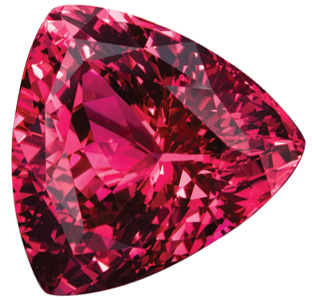
Spirits were high at February’s 2013 AGTA GemFair in Tucson, Arizona. With a slight increase in the number of attending buyers, busy traffic and big sales were the talk of the show. “The show went wonderfully,” says Douglas K. Hucker, chief executive officer (CEO) of American Gem Trade Association (AGTA), who notes there was an especially large crowd during the first three days of the six-day show.
“People were there for a purpose — they were buying,” Hucker says. AGTA has been focused on attracting high-quality buyers to the event over the past three years, and the strategy has paid off. With the jewelry market finally discovering the potential of color, the Tucson show has become one of the industry’s most popular events. “We are the biggest thing the city has — the gemstone experience,” Hucker says. Along with educational seminars and panels, fun events added to the show spirit and buyer enthusiasm, including a buyer-appreciation party on the show floor with cocktails and a live mariachi band, local food trucks lined up for lunch and a daily drawing for $1,000 to $2,000 in prize money to spend on the show floor. “There was more buzz and excitement this year than there was in previous years,” Hucker states.
Here are some of the gemstones that helped generate an uptick in interest and sales.

|
Red spinel from Tanzania. Courtesy Even Caplan Fine Gemstones. Photo by Van Pelt. |
Spinel was undoubtedly a star of the AGTA show floor. Experts note it has taken awhile for the stone to be fully recognized — even its name is not as dazzling as many of its competitors on the market — but the time for spinel has come. The stone is hot now, says Jason Stephenson of Pala International in Fallbrook, California, because there’s an increasing worldwide market for the gem.
Buyers in Russia and China are competing for spinel, and the European market has always liked its qualities as a natural stone in a wide variety of colors. Since spinel does not need treatment to enhance its color and quality, it’s an in-demand natural alternative to sapphire or ruby. Availability in a rainbow of hues like red, blue, violet and pink — which come mainly from Burma, Tanzania and Tajikistan, along with some blue spinel from Vietnam — make it desirable to a range of color preferences.
Susan Bachman of John M. Bachman Inc. in Boulder, Colorado, agrees that there is a heightened interest in spinel. In the past few years, high-end African spinel has been popular, Bachman states, but now the market is expanding to include a range of rose, lavender and blue stones from Sri Lanka and Tanzania. John M. Bachman of his eponymous firm estimates that prices for spinel have soared in the past ten years, from $350 per carat to today’s prices of about $1,500 per carat. In fact, Stephenson estimates that spinel is undergoing the greatest jump in price among all gemstones — he guesses suppliers in Bangkok are increasing prices 20 percent to 30 percent quarterly.
“Red spinel is a stone on everyone’s mind,” Hucker notes. It’s an affordable alternative to the significantly pricier ruby, in a similar vivid red. Although red spinel’s prices have increased over the past three to four years, current rates of about $1,500 to $2,000 per carat still make it an affordable purchase for jewelry. Jerry Romanella of Commercial Mineral Co. in Scottsdale, Arizona, says the company actually sold its best Tanzanian spinel prior to the show. He notes that it is quite rare and the top of the market is strong, with a 10-carat rare red spinel from Tanzania currently valued at about $10,000 per carat.
“Spinel is popular because it is a beautiful stone that comes in many colors, and in shades from subtle pastels to rich, intense and vibrant hues,” says Evan Caplan of Evan Caplan Fine Gemstones in Los Angeles, California. “The most in-demand spinel color is red. In fact, one of the most famous rubies in the world, the Black Prince’s Ruby in the British Crown Jewels, is actually a red spinel.”
Of major interest? “All things green,” Hucker says, which of course includes emerald. The rich green hue was named Pantone’s 2013 color of the year, and the shade is saturating everything from fashion and home décor to high-end jewelry. Pantone’s buzz-worthy green has made emerald gemstones hot, according to Jonathan Gad of Monte Carlo Gems in New York City. He says that prices for emeralds have increased about 35 percent since September 2012 and have generally doubled in the past year, due in part to low production and market instability in Colombia — the source of some of the world’s most beautiful emeralds — and great demand for the stone in India and China. Gad estimates the current price for emerald is $1,500 per carat and higher for finer-quality Colombian gems. Faced with the short supply and high prices of Colombian goods, some dealers are also beginning to source Zambian emeralds, which start at about $800 a carat for the better-quality finds.
Simon Watt of Mayer & Watt in Maysville, Kentucky, agrees that green is hot. He showcased rare Colombian emerald trapiches — six crystals grown together in a clump and then polished — that can be set like a cabochon.
The market’s desire for green has popularized other similarly hued gemstones as well. A high-end alternative to emerald, the rarer gemstone tsavorite was also a star at the show. The best tsavorite is coming from Tanzania, which produces the most saturated green colors, says Adam Gil of Jerry Gil & Co. in New York City. The finest-quality material begins at about $800 per carat for small pieces of less than 2 carats, while larger stones of 5 carats or more can go up to $5,000 per carat.
Moving along the popular blue-green spectrum, tourmaline, in appealing greenish hues with names like mint and lagoon, also attracted GemFair buyers. Blue-green or aqua Brazilian tourmaline is seen as good luck in the Asian market, which likes good clean stones, says Commercial Mineral’s Romanella. He estimates that prices for tourmaline have increased anywhere from 50 percent to 100 percent in the past three to five years. Although the price of all good stones has gone up, there is not a lot of new tourmaline on the market, so people are buying older stones.
Pala International displayed what it calls “neon tourmaline,” brightly hued gems in shades of blue and green. Pala’s Stephenson notes that all the best tourmaline, namely, the intense blues, is gone; the Mozambique deposit that produced these stones is done, he says. What is available now are the lighter, more included blue-green neon stones. However, due to demand, prices of even the included gems have been high since they first came out of the ground, and the market has essentially become accustomed to the costs. Tourmaline ranges from about $600 to $1,400, or even $4,500 a carat; for larger, better-quality stones of 5 carats or more, prices can jump to $10,000 to $15,000 per carat.
Paraiba tourmaline, in particular, with its beautiful, bright blue-green, is popular because of the gorgeous mystique of its rare coloration, notes Gil. He says the stones from Brazil are rarer and more desirable for their densely saturated shade that distinguishes them from other tourmaline.
Whatever its source, due to the demand for tourmaline and the low supply, prices are on the rise. Whereas Paraiba sold for a few hundred dollars a carat in 1989, the finest quality currently goes for up to $25,000 per carat or more. However, Rich Barker of Barker & Co. in Scottsdale, Arizona, says his company hasn’t seen good new parcels of Mozambique Paraiba-like tourmaline in over a year, so it hasn’t marked up prices on the stones currently in inventory and is charging $3,000 to $5,000 per carat.
But the buzz at GemFair went beyond just blue and green. For instance, fancy sapphire continues to gain ground. Natural sapphire is especially sought after in every shade, from brilliant hues of orange from Tanzania to purplish color-change sapphire from Madagascar, proving there’s plenty of room on the color wheel for all tastes and preferences. A wide range of other gemstones from pearls to peridot had buyers at the show taking notice.
But perhaps the most important factor at this year’s show was that buyers weren’t just networking and browsing — they were placing orders. “People were willing to buy this year,” Hucker concludes.
Article from the Rapaport Magazine - March 2013. To subscribe click here.